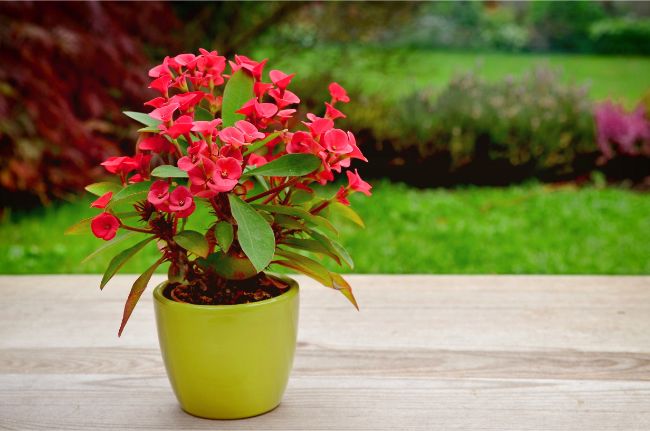The ever-blooming Crown of Thorns (Euphorbia milii) is one of the oldest houseplants. It’s easy to care for—with a few caveats—and comes with many variations to keep your home in cheerful multicolor year-round.
How do you care for a Crown of Thorns Plant? Provide your crown of thorns plant with bright, direct sunlight, temperatures of 65-90°F (18-32°C), low humidity and fast draining sandy soil. Water when the top inch of soil is dry, prune to maintain shape and fertilize lightly with a low nitrogen fertilizer every 2-3 weeks.
The spine-studded stems are a giveaway that it favors cactus-like conditions, but some special techniques help get the most from this venerable plant. Care is needed when handling, but by observing precautions and with these growing tips, you can enjoy one of the great set-and-forget houseplants of all time.
Crown Of Thorns Plant Overview
Euphorbia milii have been kept as houseplants the world over. Their easy care and continuous blooming have made them a favorite for centuries. It’s also one of the best plants for beginners. They love our dry homes.
Their memorable name comes from the ancient belief that Euphorbia milii, also called Christ’s Thorn, was the plant from which Jesus’ mock crown was plaited.
These tough customers can handle extreme conditions and survive for more than a century. Like the spine-stemmed rose, it offers beauty along with its thorns. The spines aren’t the real danger, however – their caustic sap is more dangerous. It must be treated with caution.
Though it is planted outdoors in warm climates, the Crown of Thorns is wonderful in containers. It’s a great patio plant for hot weather and is highly resistant against pests—including deer and rabbits. They’re excellent for the seaside or beach as they don’t mind saltwater spray.
The flowers come in varying shades of red and yellow … multi-colored pastels have been developed in hybrids, too. There are innumerable varieties.
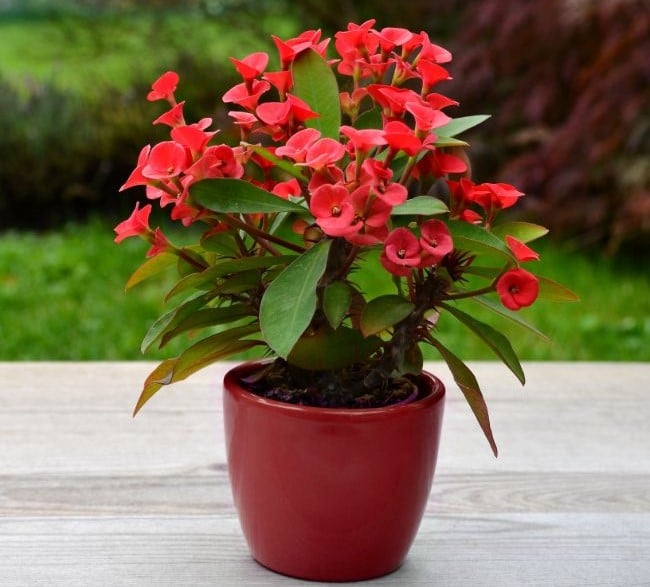
Characteristics Of Euphorbia Milii
The Crown of Thorns is a leafy, highly branched, woody succulent native to Madagascar. It may grow into a large bush outdoors but is much smaller when grown in containers.
They are part of the Euphorbiaceae, or Spurge, family that includes Poinsettias, Castor Bean, and Cassavas (which gives us tapioca). They have a sticky, toxic white latex sap that flows from their stems and other plant parts when cut.
Its gray stems are covered with spiny thorns. The ovoid leaves are wider near the tip and can be from one to six inches long. They’re fairly slow growers, and the lower sections of their stems shed leaves as they age. This can give the plant a scraggly look over time, but they’ll sprout leaves on new growth after pruning.
The Crown of Thorns’ ornamental value is in their flowers—or, what most of us call flowers; botanists don’t. Each stem forks at the tip into an insignificant flower cupped within broad modified leaves called bracts: these bracts are the colorful part. This is why their indestructible “blooms” last so long: they are a form of leaf. For our purposes, we’ll call the whole showy assembly a flower.
They do best with limited watering in porous soil and lots of light. These Euphorbias can take extremes of these factors—but moisture is its kryptonite.
Crown Of Thorns Plant Care Needs
- Scientific Name: Euphorbia Milii
- Common Name: Crown Of Thorns, Christ Plant
- Origin: Madagascar
- Light Requirements: Full, direct sunlight.
- Watering: Water once the top inch of soil is dry. Can tolerate underwatering but will drop leaves.
- Soil: Cactus potting mix or make your own with equal parts potting soil, coarse sand and perlite.
- Temperature: 65-90°F (18-32°C). May start to lose leaves below 60°F (15°C).
- Fertilizer: A succulent formula with lower nitrogen and NPK values like 2-4-7 or 3-4-5 is suitable. Higher nitrogen will promote foliage without blooms.
- Humidity: Low to medium humidity. Not fussy.
- Pruning: Responds well to pruning to shape plant. Wear gloves as sap is irritant to skin.
- Propagation: Stem propagation is very easy. Seed propagation takes longer, but very achievable.
- Re-Potting: Blooms better when rootbound. Wait to repot until has outgrown the pot.
- Diseases and Pests: Very pest and disease resistant. Overwatering is the biggest problem as will cause root rot.
- Toxicity: Toxic. Skin contact causes significant irritation. Ingestion causes pain and GI upset. Take precautions with children and pets. Wear gloves when pruning and repotting.
- Where To Buy: Buy a Crown Of Thorns Plant online at Etsy (I buy most of my houseplants from Etsy).
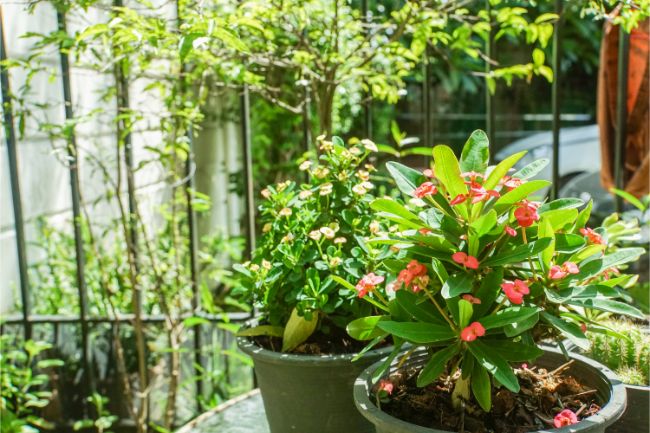
Big Differences In Crown Of Thorns Care Among Varieties
The care your plant needs depends upon its type. Extensive hybridization has created an amazing variety. One of the great things about the Crown of Thorns is how they lend themselves to large, easy-to-keep collections.
Some varieties are more tropical than others … some have fewer or smaller thorns, some favor more or less water or light. There are specimens that grow into six foot tall bushes and others that reach only a few inches high. Hybrids from Thailand grow particularly large, attractive flowers.
We’ll outline the needs of plants closest to the succulent-like original, but remember this is only a departure point. Learn what your own variety prefers. The final authority is your plant’s success.
Crown Of Thorns Plant Light Requirements
This plant loves full, direct sun. It can thrive in partial shade, but you may not see many flowers. In general, the more intense their exposure to hot rays, the more intensely they’ll flower … though some hybrids do better in less light than others.
They can need some protection from noon-day scorching, but it’s not a problem indoors. As a houseplant, it belongs in the sunniest window or patio nook you have available—supplement with a grow light if necessary. You want the exposure to be extended, too.
It’s hard to overdo the daytime lumens, but do give them some darkness every night. They need time off to make flowers.
Euphorbia Milii Watering Needs
As a succulent, the Crown of Thorns stores water in its thick stems. It can survive a long time between drinks—but regular watering helps them stay leafy. Just be aware that too much water encourages a profusion of green leaves without many flowers … or worse, it can bring rot or disease.
The leaves curl if they need water, but don’t wait that long: just let the top inch or so of topsoil dry out. If the root ball begins to dry, the plant will start losing leaves—but overwatering does that, too. If you’re paying attention it shouldn’t be hard to know which it is. Read further about how to tell if your houseplants need water.
When you do water, make it count. Saturate the soil thoroughly. Make sure it drains completely. Reduce watering in the cool season after flowering tapers off.
Incidentally, some hybrids have more tropical characteristics and need more frequent watering … but always hold off if you’re unsure.
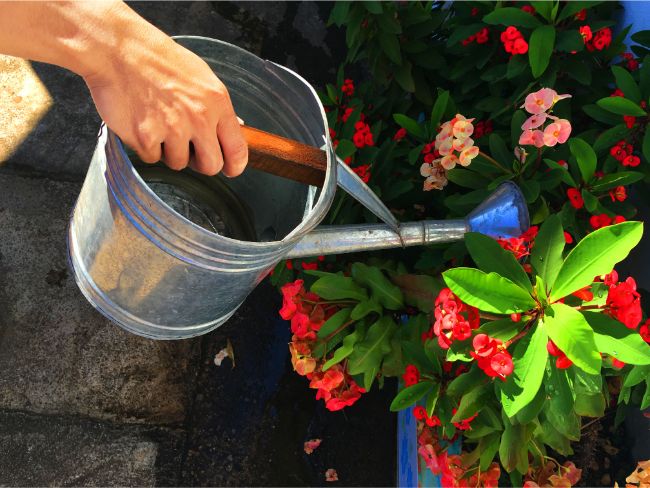
Poor, Porous Soil Is Ideal For Crown Of Thorns Plants
The most important element of a Crown of Thorn’s soil is that it drains well. They can thrive in poor soil, but not if it’s soggy. Soils that are too rich encourage leaves, not flowers; they can also promote rot.
A good cactus potting soil works fine. You can mix your own with equal parts loam, sand and perlite. Amendments like pumice or lava rock are fine, too: as long as it drains, the plant isn’t picky.
Pro Tip: Cinnamon is a friend of Euphoria. It’s a natural way to prevent root rot and fungus. Pressing a cinnamon stick into a cut area is a useful rot preventative—just remember to protect your hands from the sap.
Temperature Requirements
Crown of Thorns prefer normal room temperatures. Our comfortable homes are perfect.
Houseplants do great outside during the warm season, but they don’t like cold weather. They’ll start to lose leaves and sulk if the temps go below 60°F (15°C). They’ll survive down to about 35°F (1°C), but not for long. Bring them indoors before the temps drop.
Ground plantings can overwinter outdoors in USDA Zones 9-11.
Light Feeding
The Crown of Thorns grows rather slowly and doesn’t like too much fertilizer. They’ll do better and bloom more with light applications. A succulent formula with lower nitrogen and NPK values like 2-4-7 or 3-4-5 is suitable.
One popular method is to dissolve a weak mix of fertilizer in water and apply every two weeks through the warm season. Don’t overdo or you’ll get lots of leaves and few flowers. Some owners only feed twice: spring and early fall.
Hold off once blooming slows down in cooler weather.
Humidity
So many beautiful houseplants need more humidity than our dry homes offer—this plant is a happy exception.
Put it in a sunny window and enjoy.
Worry-free Flowering
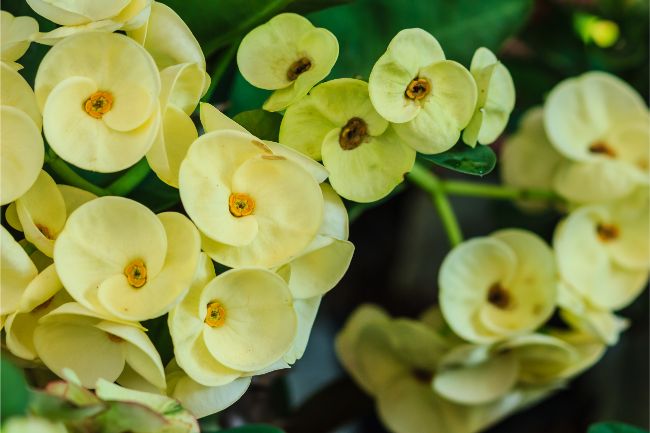
The Crown of Thorns is a confidence builder because it’s so easy and ever-blooming. Even a specimen with a single stalk and one leaf is likely to feature a flower, too.
Some floral beauties have a laundry list of conditions, but Euphorbia milii has just one: light. Don’t give it rich soil, don’t give it humidity, don’t overwater … just give it warm sunshine.
If you’re having trouble getting the profusion you’d like, don’t forget its daily period of darkness. Also, removing lower leaves seems to concentrate the plant’s energy on its job.
Crown Of Thorns Plant Toxicity Warning
Those vicious-looking thorns are actually rather flexible and their fearsome appearance reminds you to wear gloves. The Euphorbia’s real danger is their poisonous sap.
A toxic, sticky latex oozes forth from any cut—even from its roots. It can affect you like poison ivy. The common name of the plant’s family, Spurge, comes from the same root as purge and expurgate. Also not comforting: this genus provides the active ingredient in poison arrows.
Rinse off sap immediately with soapy water. It congeals like the latex it is and becomes difficult to remove. You do not want this sap in your eyes; if so, the pain will alert you to attend the nearest hospital.
Needless to say, keep children and pets safely away. Its thorns help in this, but don’t take chances. Don’t even plant them near stocked ponds … sap from broken roots can kill fish.
How To Prune Crown Of Thorns Plant
Always wear gloves when pruning. This is one of the few plants that can turn pruning into a medical emergency.
That said, the plant is quite amenable to shaping. It responds nicely to having leafless stems pruned … it regrows not only the stem, but the leaves it had lost.
You can fashion the plant into a natural shrub form, or let single stems stretch up like little trees. It’s easy to create interesting specimens.
The only concern, besides safety, is to avoid letting pruned areas get wet before they self-seal. Don’t water after cutting, and don’t prune when rain is imminent.
Pro Tip: Use waterproof glue to seal cuts quickly.
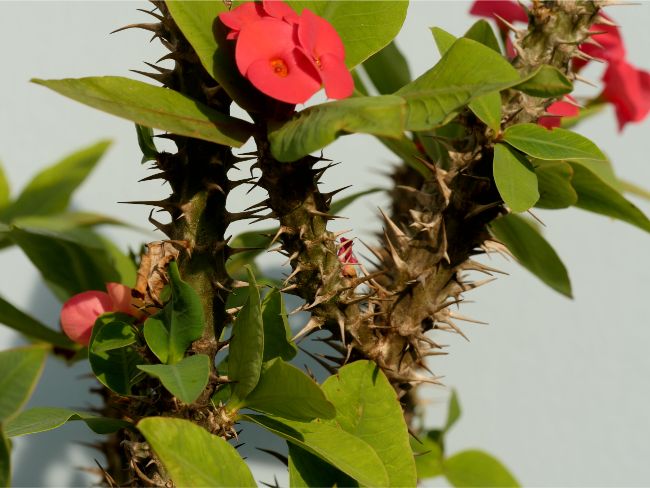
How To Propagate Euphorbia Milii
Crown of Thorns can be raised from seed by hand pollination and such, but let’s do it the easy way: stem propagation.
1) Begin by cutting a three- to six-inch stem tip in the spring or early summer. Put the cut end in cold water to help harden the latex sap.
2) Set aside the cutting to dry for two or three days. It’s strange, but go with it.
3) Place the dry cutting it into a porous succulent mix. It’s recommended to first dip the callused end in rooting hormone that includes fungicide.
4) Keep the medium warm and slightly moist—not wet and not dry. They should have roots in five to eight weeks. Shortly thereafter, growth will emerge.
5) Once they have about two inches of top growth, re-pot into well-draining soil and treat them as adults.
Crown Of Thorns Planting Tips
If you live in a cold area, you can move potted plants outdoors for the summer. Acclimate before putting them in hot sun.
Groom your Crown of Thorns by removing dead leaves and expired flowers. Besides the aesthetic value, this helps prevent fungal diseases.
Immediately cut off any plant part that turns brown and mushy: roots, stems, leaves, whatever.
It’s a good practice to let the plant rest for four to six weeks each year. Cut back on watering and take it out of bright light to give it time to recharge.
Should You Repot A Crown Of Thorns Plant
A Crown of Thorns doesn’t need frequent re-potting. Wait until the plant has outgrown its container: they bloom best when rootbound. Hold off if you’re unsure—they can live happily for years in the same pot.
Growing season is the best time. Use the recommended well-draining soil and replant to the same level. Placing the stem below its previous depth can cause decay.
These plants also don’t need a lot of space—they don’t bloom well in an oversized pot. (Tropical hybrids can be an exception.) They can grow in almost any container: bottle planters, gardening trays, terrariums, etc.
A plain, unglazed clay pot is a good choice, because it lets soil breathe. Another sensible idea is to ensure lots of drainage holes to minimize the risk of waterlogged soil.
Diseases And Pests
Crown of Thorns are basically disease and pest free. Between woody stems, bristling thorns and poisonous sap it’s apparently not too appetizing. Unless the plant gets too much water—then all bets are off.
The biggest concern is root rot. It happens easily and spreads quickly. Get into the habit of checking their soil for brown mushy roots. You’ll soon learn the smell. Remove from your crown of thorns plant from the pot, cut away all rot, sprinkle the area with cinnamon or other fungicide without delay, and repot in an a well draining potting mix.
Sometimes a pot with insufficient drainage will trap moisture. Investigate your pot’s lower regions if you have recurring issues.
Common Problems And Questions
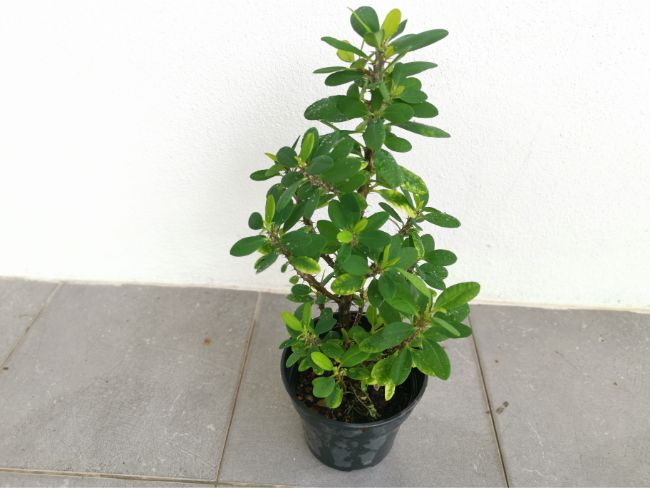
Why Is My Crown Of Thorns Not Blooming?
Crown of thorns plants need lots of bright, direct sunlight and plenty of water to get the best blooms. Excessive fertilization can also reduce blooming, particularly high nitrogen preparations, as these will promote green growth at the expense of flowers.
Excessive pruning in late summer and excessive temperature fluctuation can also shock the plant and lead to many fewer blooms the following season.
My Crown Of Thorns Plant Is Dying Due To Neglect. How Can I Fix It?
These plants live for decades through thick and thin. Even if it looks barren and forlorn, there’s probably life in it yet. The rule is not to make immediate big changes.
If the top few inches of the soil are dry, give it a thorough drink with conditioned water—but check first. Then continue watering as recommended. Groom dead stems and flowers, but don’t fertilize immediately. Wait until spring and feed very lightly until you see new growth.
Don’t re-pot right away. Wait for the right season, and consider rooting new plants from its cuttings first. That way you’ll be more relaxed about the results.
We Have A Large Crown Of Thorns Plant To Move. Should We Prune Beforehand To Avoid The Thorns?
No, a transplant is better off regrowing roots than dealing with pruning shock. An easier way is to dig it out until it falls over, and handle them by their roots!
Are Crown Of Thorns Plants Drought-Resistant?
Crown of Thorns isn’t a desert plant, but it fares well in dry conditions. They naturally look great when planted beside large rocks or in a pot with other succulent types.
Why Is My Crown Of Thorns Plant Losing Leaves?
It’s natural to lose leaves from the lower part of a stem, but leaf loss all over the plant is usually one of two things:
Overwatering – The plant can handle excess water in the bright light of growing season, but you need to cut back in late fall and winter. If you see (or smell) root rot, remove the damaged portions and rectify the situation.
Changed Conditions – Moving inside can cause leaf-loss, as can a change in light or simply a new location.
Reexamine your watering schedule and make sure their light is sufficient … and give them time. They are forgiving of missteps and can regrow leaves once conditions improve.

